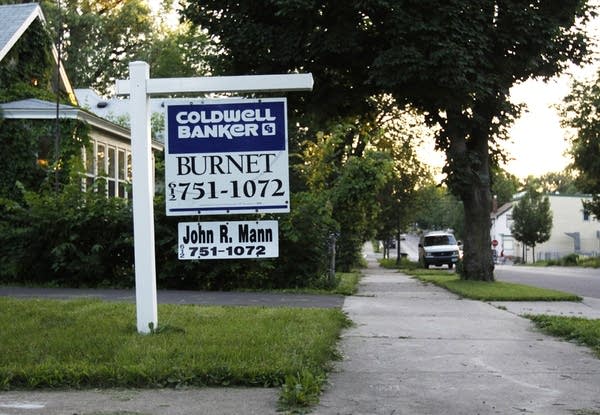Twin Cities home prices second worst from Aug.-Sept.
Go Deeper.
Create an account or log in to save stories.
Like this?
Thanks for liking this story! We have added it to a list of your favorite stories.

A slate of data releases shows the Twin Cities residential and commercial real estate markets are still struggling to recover.
The Standard & Poor's Case-Shiller home price index indicates Twin Cities home prices dropped 2.1 percent from August to September.
Among the 20 cities the index tracks, that drop was the second worst. Cleveland had the biggest decrease.
The Twin Cities index showed home prices had been ticking up in the spring and early summer before starting to drop again.
Turn Up Your Support
MPR News helps you turn down the noise and build shared understanding. Turn up your support for this public resource and keep trusted journalism accessible to all.
In an email, David Guarino, a spokesman for Standard & Poor's, says the Minneapolis market's volatility "is due to foreclosure sales (as a proportion of total sales) increasing rapidly over the past 3 years." Foreclosed properties sell at a lower price relative to comparable non-foreclosed properties.
"Increasing and more volatile volumes of foreclosure sales generate more volatility in the Case-Shiller price index," Guarino noted.
But Scott Anderson, an economist with Wells Fargo, has another explanation for the apparent volatility in the Twin Cities Case-Shiller numbers for September.
"The drop in housing demand has been more severe in the Twin Cities than it has been nationally, so I guess I am not surprised that the Twin Cities had some of the largest home price declines in the nation," Anderson said in an email.
Anderson says housing demand has been weak since May, while housing inventory -- the number of homes for sale -- has been on the rise. That dynamic of greater supply and lower demand pushes home prices down. Anderson projects home prices will continue to drop over the coming year.
"This will increase the financial pressure on households, and prolong the credit problems in the banking system, sapping the vitality of the economic recovery again next year," he said.
However, a report out Tuesday from Minneapolis Area Association of Realtors shows a small improvement on the housing supply front. It says that while housing inventory levels are still increasing, the rate of increase has been tapering off a bit over the last three weeks. Active listings are down 9.6 percent from last year.
That could be good news for homebuilders, who have been hit hard in the recession.
Another set of numbers released Monday from the Builders Association of the Twin Cities reflects some recent improvements. It shows that permits in November are 17 percent higher than the same month last year. Planned units are up by 30 percent year over year.
But current levels remain well below where they were five years ago.
Meanwhile, optimism among commercial real estate leaders is up slightly compared to six months ago, according to a survey released Monday by the University St. Thomas. The survey asked 50 commercial real estate leaders about their outlook on market conditions between now and 2012.
The firms represented by the leaders make up roughly 60 percent of the Twin Cities commercial real estate market.
Herb Tousley, director of the real estate programs at the University of St. Thomas, says the survey's composite index registered 53.5 last Spring, and increased to 54.1 this Fall. A composite index value over 50 signals optimism.
"They're not jumping up and down in the streets quite yet. It's still a good sign that they're optimistic and that has increased a little bit."
Tousley says the commercial real estate leaders' optimism increased with respect to financing but decreased slightly concerning occupancy rates.
Occupancy rates are a key measure of the health of the commercial market. Vacant space exerts a significant drag on the market.




